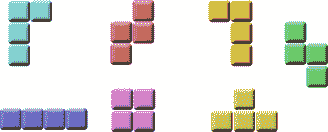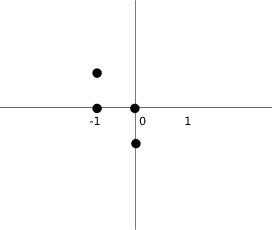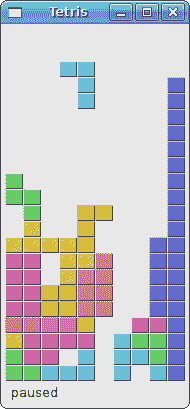在本章中,我们将创建一个俄罗斯方块游戏克隆。
俄罗斯方块
俄罗斯方块游戏是有史以来最受欢迎的计算机游戏之一。 原始游戏是由俄罗斯程序员 Alexey Pajitnov 于 1985 年设计和编程的。此后,几乎所有版本的几乎所有计算机平台上都可以使用俄罗斯方块。
俄罗斯方块被称为下降块益智游戏。 在这个游戏中,我们有七个不同的形状,称为 tetrominoes :S 形,Z 形,T 形,L 形,线形,MirroredL 形和正方形。 这些形状中的每一个都形成有四个正方形。 形状从板上掉下来。 俄罗斯方块游戏的目的是移动和旋转形状,以使其尽可能地适合。 如果我们设法形成一行,则该行将被破坏并得分。 我们玩俄罗斯方块游戏,直到达到顶峰。

图:Tetrominoes
PyQt4 是旨在创建应用的工具包。 还有其他一些旨在创建计算机游戏的库。 不过,PyQt4 和其他应用工具包可用于创建简单的游戏。
创建计算机游戏是增强编程技能的好方法。
开发
我们的俄罗斯方块游戏没有图像,我们使用 PyQt4 编程工具包中提供的绘图 API 绘制四面体。 每个计算机游戏的背后都有一个数学模型。 俄罗斯方块也是如此。
游戏背后的一些想法:
- 我们使用
QtCore.QBasicTimer()创建游戏周期。 - 绘制四方块。
- 形状以正方形为单位移动(而不是逐个像素移动)。
- 从数学上讲,棋盘是一个简单的数字列表。
该代码包括四个类别:Tetris,Board,Tetrominoe和Shape。 Tetris类设置游戏。 Board是编写游戏逻辑的地方。 Tetrominoe类包含所有俄罗斯方块的名称,Shape类包含俄罗斯方块的代码。
#!/usr/bin/python# -*- coding: utf-8 -*-"""ZetCode PyQt4 tutorialThis is a Tetris game clone.author: Jan Bodnarwebsite: zetcode.comlast edited: October 2013"""import sys, randomfrom PyQt4 import QtCore, QtGuiclass Tetris(QtGui.QMainWindow):def __init__(self):super(Tetris, self).__init__()self.initUI()def initUI(self):self.tboard = Board(self)self.setCentralWidget(self.tboard)self.statusbar = self.statusBar()self.tboard.msg2Statusbar[str].connect(self.statusbar.showMessage)self.tboard.start()self.resize(180, 380)self.center()self.setWindowTitle('Tetris')self.show()def center(self):screen = QtGui.QDesktopWidget().screenGeometry()size = self.geometry()self.move((screen.width()-size.width())/2,(screen.height()-size.height())/2)class Board(QtGui.QFrame):msg2Statusbar = QtCore.pyqtSignal(str)BoardWidth = 10BoardHeight = 22Speed = 300def __init__(self, parent):super(Board, self).__init__(parent)self.initBoard()def initBoard(self):self.timer = QtCore.QBasicTimer()self.isWaitingAfterLine = Falseself.curX = 0self.curY = 0self.numLinesRemoved = 0self.board = []self.setFocusPolicy(QtCore.Qt.StrongFocus)self.isStarted = Falseself.isPaused = Falseself.clearBoard()def shapeAt(self, x, y):return self.board[(y * Board.BoardWidth) + x]def setShapeAt(self, x, y, shape):self.board[(y * Board.BoardWidth) + x] = shapedef squareWidth(self):return self.contentsRect().width() / Board.BoardWidthdef squareHeight(self):return self.contentsRect().height() / Board.BoardHeightdef start(self):if self.isPaused:returnself.isStarted = Trueself.isWaitingAfterLine = Falseself.numLinesRemoved = 0self.clearBoard()self.msg2Statusbar.emit(str(self.numLinesRemoved))self.newPiece()self.timer.start(Board.Speed, self)def pause(self):if not self.isStarted:returnself.isPaused = not self.isPausedif self.isPaused:self.timer.stop()self.msg2Statusbar.emit("paused")else:self.timer.start(Board.Speed, self)self.msg2Statusbar.emit(str(self.numLinesRemoved))self.update()def paintEvent(self, event):painter = QtGui.QPainter(self)rect = self.contentsRect()boardTop = rect.bottom() - Board.BoardHeight * self.squareHeight()for i in range(Board.BoardHeight):for j in range(Board.BoardWidth):shape = self.shapeAt(j, Board.BoardHeight - i - 1)if shape != Tetrominoe.NoShape:self.drawSquare(painter,rect.left() + j * self.squareWidth(),boardTop + i * self.squareHeight(), shape)if self.curPiece.shape() != Tetrominoe.NoShape:for i in range(4):x = self.curX + self.curPiece.x(i)y = self.curY - self.curPiece.y(i)self.drawSquare(painter, rect.left() + x * self.squareWidth(),boardTop + (Board.BoardHeight - y - 1) * self.squareHeight(),self.curPiece.shape())def keyPressEvent(self, event):if not self.isStarted or self.curPiece.shape() == Tetrominoe.NoShape:super(Board, self).keyPressEvent(event)returnkey = event.key()if key == QtCore.Qt.Key_P:self.pause()returnif self.isPaused:returnelif key == QtCore.Qt.Key_Left:self.tryMove(self.curPiece, self.curX - 1, self.curY)elif key == QtCore.Qt.Key_Right:self.tryMove(self.curPiece, self.curX + 1, self.curY)elif key == QtCore.Qt.Key_Down:self.tryMove(self.curPiece.rotateRight(), self.curX, self.curY)elif key == QtCore.Qt.Key_Up:self.tryMove(self.curPiece.rotateLeft(), self.curX, self.curY)elif key == QtCore.Qt.Key_Space:self.dropDown()elif key == QtCore.Qt.Key_D:self.oneLineDown()else:super(Board, self).keyPressEvent(event)def timerEvent(self, event):if event.timerId() == self.timer.timerId():if self.isWaitingAfterLine:self.isWaitingAfterLine = Falseself.newPiece()else:self.oneLineDown()else:super(Board, self).timerEvent(event)def clearBoard(self):for i in range(Board.BoardHeight * Board.BoardWidth):self.board.append(Tetrominoe.NoShape)def dropDown(self):newY = self.curYwhile newY > 0:if not self.tryMove(self.curPiece, self.curX, newY - 1):breaknewY -= 1self.pieceDropped()def oneLineDown(self):if not self.tryMove(self.curPiece, self.curX, self.curY - 1):self.pieceDropped()def pieceDropped(self):for i in range(4):x = self.curX + self.curPiece.x(i)y = self.curY - self.curPiece.y(i)self.setShapeAt(x, y, self.curPiece.shape())self.removeFullLines()if not self.isWaitingAfterLine:self.newPiece()def removeFullLines(self):numFullLines = 0rowsToRemove = []for i in range(Board.BoardHeight):n = 0for j in range(Board.BoardWidth):if not self.shapeAt(j, i) == Tetrominoe.NoShape:n = n + 1if n == 10:rowsToRemove.append(i)rowsToRemove.reverse()for m in rowsToRemove:for k in range(m, Board.BoardHeight):for l in range(Board.BoardWidth):self.setShapeAt(l, k, self.shapeAt(l, k + 1))numFullLines = numFullLines + len(rowsToRemove)if numFullLines > 0:self.numLinesRemoved = self.numLinesRemoved + numFullLinesself.msg2Statusbar.emit(str(self.numLinesRemoved))self.isWaitingAfterLine = Trueself.curPiece.setShape(Tetrominoe.NoShape)self.update()def newPiece(self):self.curPiece = Shape()self.curPiece.setRandomShape()self.curX = Board.BoardWidth / 2 + 1self.curY = Board.BoardHeight - 1 + self.curPiece.minY()#print self.curYif not self.tryMove(self.curPiece, self.curX, self.curY):self.curPiece.setShape(Tetrominoe.NoShape)self.timer.stop()self.isStarted = Falseself.msg2Statusbar.emit("Game over")def tryMove(self, newPiece, newX, newY):for i in range(4):x = newX + newPiece.x(i)y = newY - newPiece.y(i)if x < 0 or x >= Board.BoardWidth or y < 0 or y >= Board.BoardHeight:return Falseif self.shapeAt(x, y) != Tetrominoe.NoShape:return Falseself.curPiece = newPieceself.curX = newXself.curY = newYself.update()return Truedef drawSquare(self, painter, x, y, shape):colorTable = [0x000000, 0xCC6666, 0x66CC66, 0x6666CC,0xCCCC66, 0xCC66CC, 0x66CCCC, 0xDAAA00]color = QtGui.QColor(colorTable[shape])painter.fillRect(x + 1, y + 1, self.squareWidth() - 2,self.squareHeight() - 2, color)painter.setPen(color.light())painter.drawLine(x, y + self.squareHeight() - 1, x, y)painter.drawLine(x, y, x + self.squareWidth() - 1, y)painter.setPen(color.dark())painter.drawLine(x + 1, y + self.squareHeight() - 1,x + self.squareWidth() - 1, y + self.squareHeight() - 1)painter.drawLine(x + self.squareWidth() - 1,y + self.squareHeight() - 1, x + self.squareWidth() - 1, y + 1)class Tetrominoe(object):NoShape = 0ZShape = 1SShape = 2LineShape = 3TShape = 4SquareShape = 5LShape = 6MirroredLShape = 7class Shape(object):coordsTable = (((0, 0), (0, 0), (0, 0), (0, 0)),((0, -1), (0, 0), (-1, 0), (-1, 1)),((0, -1), (0, 0), (1, 0), (1, 1)),((0, -1), (0, 0), (0, 1), (0, 2)),((-1, 0), (0, 0), (1, 0), (0, 1)),((0, 0), (1, 0), (0, 1), (1, 1)),((-1, -1), (0, -1), (0, 0), (0, 1)),((1, -1), (0, -1), (0, 0), (0, 1)))def __init__(self):self.coords = [[0,0] for i in range(4)]self.pieceShape = Tetrominoe.NoShapeself.setShape(Tetrominoe.NoShape)def shape(self):return self.pieceShapedef setShape(self, shape):table = Shape.coordsTable[shape]for i in range(4):for j in range(2):self.coords[i][j] = table[i][j]self.pieceShape = shapedef setRandomShape(self):self.setShape(random.randint(1, 7))def x(self, index):return self.coords[index][0]def y(self, index):return self.coords[index][1]def setX(self, index, x):self.coords[index][0] = xdef setY(self, index, y):self.coords[index][1] = ydef minX(self):m = self.coords[0][0]for i in range(4):m = min(m, self.coords[i][0])return mdef maxX(self):m = self.coords[0][0]for i in range(4):m = max(m, self.coords[i][0])return mdef minY(self):m = self.coords[0][1]for i in range(4):m = min(m, self.coords[i][1])return mdef maxY(self):m = self.coords[0][1]for i in range(4):m = max(m, self.coords[i][1])return mdef rotateLeft(self):if self.pieceShape == Tetrominoe.SquareShape:return selfresult = Shape()result.pieceShape = self.pieceShapefor i in range(4):result.setX(i, self.y(i))result.setY(i, -self.x(i))return resultdef rotateRight(self):if self.pieceShape == Tetrominoe.SquareShape:return selfresult = Shape()result.pieceShape = self.pieceShapefor i in range(4):result.setX(i, -self.y(i))result.setY(i, self.x(i))return resultdef main():app = QtGui.QApplication([])tetris = Tetris()sys.exit(app.exec_())if __name__ == '__main__':main()
游戏进行了简化,以便于理解。 游戏启动后立即开始。 我们可以通过按 p 键暂停游戏。 Space 键将使俄罗斯方块立即下降到底部。 游戏以恒定速度进行,没有实现加速。 分数是我们已删除的行数。
self.tboard = Board(self)self.setCentralWidget(self.tboard)
创建Board类的实例,并将其设置为应用的中央窗口小部件。
self.statusbar = self.statusBar()self.tboard.msg2Statusbar[str].connect(self.statusbar.showMessage)
我们创建一个状态栏,在其中显示消息。 我们将显示三种可能的消息:已删除的行数,暂停的消息或游戏结束消息。 msg2Statusbar是在Board类中实现的自定义信号。 showMessage()是一种内置方法,可在状态栏上显示一条消息。
self.tboard.start()
这条线启动了游戏。
class Board(QtGui.QFrame):msg2Statusbar = QtCore.pyqtSignal(str)...
创建自定义信号。 msg2Statusbar是当我们要向状态栏写消息或乐谱时发出的信号。
BoardWidth = 10BoardHeight = 22Speed = 300
这些是Board's类变量。 BoardWidth和BoardHeight以块为单位定义电路板的大小。 Speed定义游戏的速度。 每 300 毫秒将开始一个新的游戏周期。
...self.curX = 0self.curY = 0self.numLinesRemoved = 0self.board = []...
在initBoard()方法中,我们初始化了一些重要的变量。 变量self.board是从 0 到 7 的数字的列表。它表示各种形状的位置以及板上形状的其余部分。
def shapeAt(self, x, y):return self.board[(y * Board.BoardWidth) + x]
shapeAt()方法确定给定块上的形状类型。
def squareWidth(self):return self.contentsRect().width() / Board.BoardWidth
电路板可以动态调整大小。 结果,块的大小可能改变。 squareWidth()计算单个正方形的宽度(以像素为单位)并将其返回。 Board.BoardWidth是板的大小,以块为单位。
for i in range(Board.BoardHeight):for j in range(Board.BoardWidth):shape = self.shapeAt(j, Board.BoardHeight - i - 1)if shape != Tetrominoe.NoShape:self.drawSquare(painter,rect.left() + j * self.squareWidth(),boardTop + i * self.squareHeight(), shape)
游戏的绘图分为两个步骤。 在第一步中,我们绘制所有形状或已放置到板底部的形状的其余部分。 所有正方形都记在self.board列表变量中。 使用shapeAt()方法访问该变量。
if self.curPiece.shape() != Tetrominoe.NoShape:for i in range(4):x = self.curX + self.curPiece.x(i)y = self.curY - self.curPiece.y(i)self.drawSquare(painter, rect.left() + x * self.squareWidth(),boardTop + (Board.BoardHeight - y - 1) * self.squareHeight(),self.curPiece.shape())
下一步是下落的实际零件的图纸。
elif key == QtCore.Qt.Key_Right:self.tryMove(self.curPiece, self.curX + 1, self.curY)
在keyPressEvent()方法中,我们检查按键是否按下。 如果按向右箭头键,我们将尝试将棋子向右移动。 我们说尝试,因为该部分可能无法移动。
elif key == QtCore.Qt.Key_Up:self.tryMove(self.curPiece.rotateLeft(), self.curX, self.curY)
向上方向键将使下降片向左旋转。
elif key == QtCore.Qt.Key_Space:self.dropDown()
空格键将立即将下降的片段降到底部。
elif key == QtCore.Qt.Key_D:self.oneLineDown()
按下 d 键,乐曲将向下移动一个格。 它可以用来加速一块的下落。
def tryMove(self, newPiece, newX, newY):for i in range(4):x = newX + newPiece.x(i)y = newY - newPiece.y(i)if x < 0 or x >= Board.BoardWidth or y < 0 or y >= Board.BoardHeight:return Falseif self.shapeAt(x, y) != Tetrominoe.NoShape:return Falseself.curPiece = newPieceself.curX = newXself.curY = newYself.update()return True
在tryMove()方法中,我们尝试移动形状。 如果形状在板的边缘或与其他零件相邻,则返回False。 否则,我们将当前的下降片放到新位置。
def timerEvent(self, event):if event.timerId() == self.timer.timerId():if self.isWaitingAfterLine:self.isWaitingAfterLine = Falseself.newPiece()else:self.oneLineDown()else:super(Board, self).timerEvent(event)
在计时器事件中,我们要么在上一个下降到底部之后创建一个新作品,要么将下降的一块向下移动一行。
def clearBoard(self):for i in range(Board.BoardHeight * Board.BoardWidth):self.board.append(Tetrominoe.NoShape)
clearBoard()方法通过在板的每个块上设置Tetrominoe.NoShape来清除板。
def removeFullLines(self):numFullLines = 0rowsToRemove = []for i in range(Board.BoardHeight):n = 0for j in range(Board.BoardWidth):if not self.shapeAt(j, i) == Tetrominoe.NoShape:n = n + 1if n == 10:rowsToRemove.append(i)rowsToRemove.reverse()for m in rowsToRemove:for k in range(m, Board.BoardHeight):for l in range(Board.BoardWidth):self.setShapeAt(l, k, self.shapeAt(l, k + 1))numFullLines = numFullLines + len(rowsToRemove)...
如果片段触底,我们将调用removeFullLines()方法。 我们找出所有实线并将其删除。 通过将所有行移动到当前全行上方来将其向下移动一行来实现。 请注意,我们颠倒了要删除的行的顺序。 否则,它将无法正常工作。 在我们的情况下,我们使用天真重力。 这意味着碎片可能会漂浮在空的间隙上方。
def newPiece(self):self.curPiece = Shape()self.curPiece.setRandomShape()self.curX = Board.BoardWidth / 2 + 1self.curY = Board.BoardHeight - 1 + self.curPiece.minY()if not self.tryMove(self.curPiece, self.curX, self.curY):self.curPiece.setShape(Tetrominoe.NoShape)self.timer.stop()self.isStarted = Falseself.msg2Statusbar.emit("Game over")
newPiece()方法随机创建一个新的俄罗斯方块。 如果棋子无法进入其初始位置,则游戏结束。
class Tetrominoe(object):NoShape = 0ZShape = 1SShape = 2LineShape = 3TShape = 4SquareShape = 5LShape = 6MirroredLShape = 7
Tetrominoe类包含所有可能形状的名称。 我们还有一个NoShape用于空白。
Shape类保存有关俄罗斯方块的信息。
class Shape(object):coordsTable = (((0, 0), (0, 0), (0, 0), (0, 0)),((0, -1), (0, 0), (-1, 0), (-1, 1)),...)...
coordsTable元组保存我们的零件的所有可能的坐标值。 这是一个模板,所有零件均从该模板获取其坐标值。
self.coords = [[0,0] for i in range(4)]
创建后,我们将创建一个空坐标列表。 该列表将保存俄罗斯方块的坐标。

图:坐标
上面的图片将帮助您更多地了解坐标值。 例如,元组(0,-1),(0,0),(-1,0),(-1,-1)表示 Z 形。 该图说明了形状。
def rotateLeft(self):if self.pieceShape == Tetrominoe.SquareShape:return selfresult = Shape()result.pieceShape = self.pieceShapefor i in range(4):result.setX(i, self.y(i))result.setY(i, -self.x(i))return result
rotateLeft()方法将一块向左旋转。 正方形不必旋转。 这就是为什么我们只是将引用返回到当前对象。 将创建一个新零件,并将其坐标设置为旋转零件的坐标。

图:俄罗斯方块
这是 PyQt4 中的俄罗斯方块游戏。

